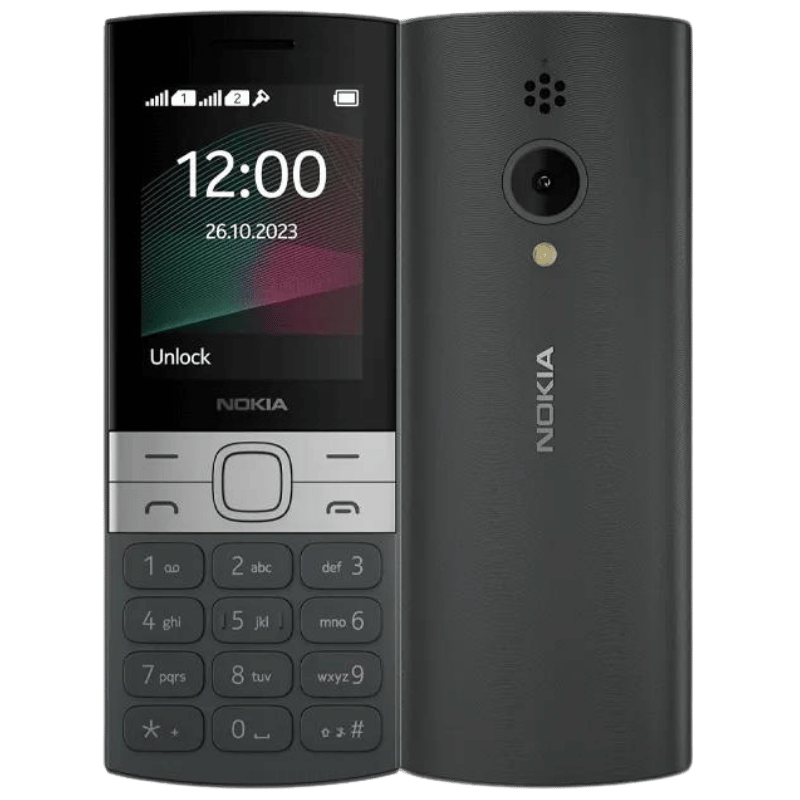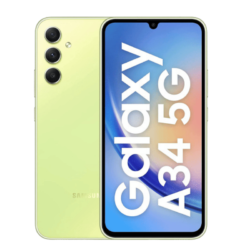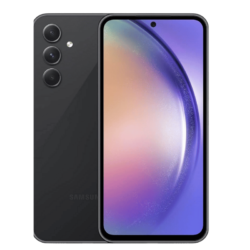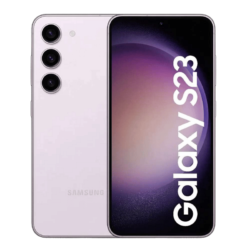Nokia 150
QR 99
The Nokia 150 is priced between QAR 99 and QAR 129, depending on the retailer and any ongoing promotions. The single SIM variant is generally priced at the lower end of this range, while the dual SIM version tends to be slightly more expensive.
Some retailers offer the Nokia 150 in different colors, such as black, white, or red, with minimal price differences between color options.
Nokia 150 Specifications
| Feature | Specification |
|---|---|
| Display | 2.4″ TFT, 65K colors |
| Resolution | 240 x 320 pixels |
| Network | GSM 900 / 1800 |
| SIM | Single SIM or Dual SIM (Mini-SIM) |
| Memory | 4MB RAM, microSD card slot (up to 32GB) |
| Camera | VGA rear camera |
| Battery | 1020 mAh Li-Ion, removable |
| Standby Time | Up to 31 days |
| Talk Time | Up to 22 hours |
| Connectivity | Bluetooth 3.0, Micro USB, 3.5mm audio jack |
| Additional Features | FM radio, MP3 player, Flashlight |
| Dimensions | 118 x 50.2 x 13.5 mm |
| Weight | 81 grams |
Release Date and Availability
The Nokia 150 was first released in January 2017, with subsequent updates and re-releases in following years. The latest version available in Qatar as of 2024 maintains the core features of the original model while incorporating minor improvements in durability and software. This feature phone has remained a popular choice for those seeking a simple, reliable device for basic communication needs.
Design and Build Quality
The Nokia 150 boasts a classic feature phone design that prioritizes functionality and durability. Its compact size (118 x 50.2 x 13.5 mm) and lightweight build (81 grams) make it easy to carry and use with one hand. The phone features a sturdy plastic body that can withstand everyday wear and tear, living up to Nokia’s reputation for building robust devices.
The 2.4-inch TFT display, while small by smartphone standards, is sufficient for reading text messages, checking the time, and navigating the phone’s menu. The screen’s 240 x 320 pixel resolution provides clear visibility for basic tasks. Below the screen, you’ll find a traditional numeric keypad with large, easy-to-press buttons, making it ideal for users who prefer tactile feedback when typing or dialing numbers.
Features and Functionality
Despite its simple appearance, the Nokia 150 offers a range of features that cater to basic communication and entertainment needs. The phone supports both single and dual SIM configurations, allowing users to manage personal and work numbers on a single device. Its 1020 mAh removable battery provides impressive standby time of up to 31 days and talk time of up to 22 hours, making it an excellent choice for those who prioritize long battery life.
The Nokia 150 comes equipped with a VGA camera, which, while basic, allows users to capture simple photos and videos. The built-in FM radio and MP3 player provide entertainment options, and the inclusion of a 3.5mm audio jack allows for private listening through headphones. The phone also features a handy LED flashlight, which can be particularly useful in areas with unreliable electricity.
Storage-wise, the Nokia 150 has 4MB of internal memory, which is expandable up to 32GB via a microSD card. This allows users to store a significant number of contacts, messages, and media files. The phone runs on Nokia’s Series 30+ operating system, which is known for its simplicity and ease of use.
Connectivity and Network Support
In terms of connectivity, the Nokia 150 supports 2G networks (GSM 900 / 1800), which is sufficient for voice calls and text messaging. However, it’s important to note that as many countries are phasing out 2G networks, this could limit the phone’s usability in some regions in the future. The device also features Bluetooth 3.0 for connecting to accessories or transferring files, and a Micro USB port for charging and data transfer.
Comparison with Other Nokia Models and Competitors
When compared to other Nokia feature phones, the Nokia 150 sits comfortably in the middle range. It offers more features than the basic Nokia 110 or Nokia 105, but doesn’t quite reach the capabilities of more advanced models like the Nokia 8110 4G or Nokia 2720 Flip. The Nokia 125, for instance, has a similar design and feature set but with a slightly smaller 2.4-inch screen and no camera. The Nokia 130, on the other hand, is very similar to the 150 but often comes at a slightly lower price point with minor differences in battery life and build quality.
Compared to the iconic Nokia 1100, which was released in 2003, the Nokia 150 represents a significant upgrade in terms of display quality, battery life, and additional features like Bluetooth connectivity and expandable storage. However, it maintains the same philosophy of providing a simple, reliable communication device.
In the broader feature phone market, the Nokia 150 competes with devices from brands like Alcatel, Jio, and various local manufacturers. Its main advantages lie in Nokia’s brand reputation for durability, the phone’s long battery life, and its balance of features at an affordable price point. However, some competitors may offer 4G connectivity or more advanced features at similar price points, which could be a consideration for some users.
When compared to entry-level smartphones available in Qatar, the Nokia 150 stands out for its significantly lower price and much longer battery life. However, it lacks the advanced functionality, app ecosystem, and internet capabilities that even budget smartphones provide. This makes the Nokia 150 an ideal choice for users who prioritize long battery life, durability, and simplicity over the features of a full-fledged smartphone.
Target Audience and Use Cases
The Nokia 150 is primarily targeted at several specific user groups. First, it appeals to older adults or technologically less savvy individuals who prefer a simple, easy-to-use phone for basic communication. The large buttons, clear display, and straightforward menu system make it an excellent choice for this demographic.
Secondly, the Nokia 150 is popular among parents looking for a first phone for their children. Its affordable price, durable build, and limited internet capabilities make it a safe and practical option for kids who need a way to stay in touch with family.
Thirdly, the phone is often chosen as a secondary or backup device by smartphone users. Its long battery life and reliability make it an excellent emergency phone or a device to use in situations where a smartphone might be at risk of damage or theft, such as at the beach, during outdoor activities, or while traveling in certain areas.
Lastly, the Nokia 150 is favored by individuals in professions or situations where a basic, long-lasting communication device is preferable. This includes workers in industrial or construction settings, travelers venturing to areas with limited charging facilities, or anyone who values a no-frills communication tool that doesn’t require frequent charging.
Battery Life and Charging
One of the standout features of the Nokia 150 is its impressive battery life. The 1020 mAh removable Li-Ion battery may seem small by smartphone standards, but it’s more than capable of powering this efficient feature phone for extended periods. With up to 31 days of standby time and up to 22 hours of talk time, the Nokia 150 significantly outperforms smartphones in terms of battery longevity.
This extended battery life is particularly beneficial for users who may not have regular access to charging facilities or those who simply prefer not to worry about daily charging. The removable nature of the battery also allows users to carry spare batteries for even longer periods of use, which can be crucial in emergency situations or during extended trips to remote areas.
Charging the Nokia 150 is done via a Micro USB port, which is a widely available standard. The phone doesn’t support fast charging, but given its small battery capacity, it doesn’t take too long to fully charge. Most users find they only need to charge the device once every few days or even weeks, depending on usage patterns.
Software and User Interface
The Nokia 150 runs on Nokia’s Series 30+ operating system, which is designed specifically for feature phones. This OS is known for its simplicity, ease of use, and efficiency, which contributes to the phone’s long battery life and smooth performance despite limited hardware resources.
The user interface is straightforward and intuitive, featuring a grid or list-based menu system that can be navigated using the physical keypad. The main menu typically includes options for Messages, Contacts, Call Log, Settings, and additional features like the Camera, Music Player, and FM Radio.
Text input is done via the T9 predictive text system or multi-tap input, which may feel nostalgic for users who remember older mobile phones but can take some getting used to for those accustomed to touchscreen keyboards.
While the software is basic compared to modern smartphones, it includes several useful applications and features:
- Contacts Management: The phone can store a large number of contacts, especially when using a microSD card for expanded storage.
- Messaging: It supports SMS text messaging, allowing users to send and receive text messages easily.
- Call Management: Features include call logs, speed dialing, and basic call settings.
- Clock and Organizer: The phone includes an alarm clock, calendar, and basic note-taking application.
- Media Player: A simple music player is included for playing MP3 files stored on the microSD card.
- FM Radio: The built-in FM radio can be used with or without headphones (which act as an antenna).
- Games: The phone typically comes with a few basic pre-installed games, such as the classic Snake.
- File Manager: A simple file management system for organizing content stored on the phone or microSD card.
While the Nokia 150 doesn’t support advanced features like internet browsing or app installations, its software is designed to be reliable, fast, and easy to use, catering well to its target audience.
Camera and Multimedia
The Nokia 150 is equipped with a basic VGA camera, which is capable of capturing low-resolution photos and videos. While the image quality is far from what you’d expect from a modern smartphone, it serves the purpose of taking quick snapshots or simple visual notes.
The camera interface is straightforward, with basic options for adjusting brightness and applying simple effects. Photos and videos can be saved to the phone’s internal memory or to a microSD card. While the camera won’t replace a dedicated digital camera or smartphone for photography enthusiasts, it can be useful for capturing simple memories or for practical purposes like documenting information visually.
In terms of multimedia capabilities, the Nokia 150 includes a basic music player that supports common audio formats like MP3. Users can store music files on a microSD card and listen through the built-in speaker or via headphones using the 3.5mm audio jack. The sound quality is adequate for casual listening, though audiophiles might find it lacking compared to dedicated music players or smartphones.
The built-in FM radio is another popular feature, allowing users to listen to local radio stations. The radio typically requires headphones to be plugged in as they serve as an antenna, but users can choose to play the audio through the phone’s speaker.
While the multimedia features of the Nokia 150 are basic by modern standards, they provide sufficient entertainment options for users who prioritize simplicity and long battery life over advanced media capabilities.
Connectivity Options
The Nokia 150’s connectivity options are limited but sufficient for its intended use as a basic communication device. Here’s a breakdown of its connectivity features:
- 2G Network: The phone supports GSM 900 and 1800 MHz bands, which are still widely used for voice calls and SMS in many parts of the world. However, it’s important to note that some countries are phasing out 2G networks, which could affect the phone’s usability in certain regions in the future.
- Bluetooth: The Nokia 150 is equipped with Bluetooth 3.0, allowing it to connect to various accessories like headsets or car audio systems. It can also be used for transferring files between compatible devices, although the transfer speeds are relatively slow compared to more modern Bluetooth versions.
- Micro USB: A Micro USB port is used for charging the device and for connecting to a computer for data transfer. This allows users to back up their contacts, transfer music files, or manage photos taken with the phone’s camera.
- 3.5mm Audio Jack: The standard 3.5mm headphone jack allows users to connect wired headphones or external speakers for private listening or better audio quality.
- MicroSD Card Slot: While not strictly a connectivity option, the microSD card slot allows users to expand the phone’s storage capacity, making it easier to transfer and store larger amounts of data.
It’s worth noting that the Nokia 150 does not support Wi-Fi or mobile data connections. This means the phone cannot be used for internet browsing, email, or other online activities. For some users, this limitation is actually a benefit, as it eliminates distractions and potential security concerns associated with internet-connected devices.
Price Comparison and Value Proposition
In the Qatari market, the Nokia 150 is positioned as an affordable feature phone, with prices ranging from QAR 99 to QAR 129. This pricing makes it one of the more accessible mobile phones available, especially when compared to entry-level smartphones which typically start at around QAR 300-400.
When compared to other feature phones in the market, the Nokia 150 offers good value for money. It’s priced similarly to or slightly higher than the most basic models like the Nokia 110 or 105, but offers additional features such as a camera and slightly larger display, justifying the small price difference.
In comparison to smartphones, the Nokia 150 is significantly cheaper. However, it’s important to consider the trade-offs. While smartphones offer vastly more functionality, including internet access, app ecosystems, and advanced multimedia capabilities, the Nokia 150 counters with extreme battery life, durability, and simplicity.The value proposition of the Nokia 150 lies in its combination of affordability, reliability, and long battery life. For users who primarily need a device for calls and texts, and who value battery longevity over advanced features, the Nokia 150 presents excellent value. Its durability and simple interface also make it a cost-effective option for those who may be hard on their devices or who prefer not to deal with the complexities of a smartphone.
However, for users who require internet connectivity, social media access, or the ability to use modern apps, the value proposition diminishes. In these cases, investing in an entry-level smartphone might provide better value despite the higher upfront cost.
Pros and Cons
To help potential buyers make an informed decision, here’s a summary of the main advantages and disadvantages of the Nokia 150:
Pros:
- Extremely long battery life
- Affordable price point
- Durable build quality
- Simple and easy-to-use interface
- Dual SIM option available
- Includes basic camera and multimedia features
- Expandable storage via microSD card
- Reliable for calls and text messaging
- Includes useful features like FM radio and flashlight
- Minimal distractions compared to smartphones
Cons:
- Limited functionality compared to smartphones
- No internet connectivity
- Basic camera quality
- Small screen size
- Limited app ecosystem
- Outdated 2G network support
- Slow data transfer speeds
- No GPS or location services
- Limited multimedia capabilities
- May become obsolete as 2G networks are phased out in some regions
Who Should Buy the Nokia 150?
The Nokia 150 is an ideal choice for several types of users:
- Seniors: Older adults who prefer a simple, easy-to-use phone with large buttons and a clear display will find the Nokia 150 appealing.
- Children: Parents looking for a first phone for their kids will appreciate the Nokia 150’s affordability, durability, and lack of internet access.
- Minimalists: Those who want to reduce digital distractions and focus on essential communication will benefit from the phone’s basic features.
- Travelers: People who need a reliable backup phone with long battery life for emergencies or travel to areas with limited charging facilities.
- Outdoor Enthusiasts: The phone’s durability and long battery life make it suitable for camping, hiking, or other outdoor activities.
- Budget-Conscious Consumers: Individuals looking for an affordable communication device without the high costs associated with smartphones.
- Workers in Challenging Environments: Those working in construction, factories, or other demanding settings where a rugged, simple phone is preferable.
- Tech-Averse Individuals: People who find smartphones overwhelming and prefer a straightforward device for calls and texts.
Alternatives to Consider
While the Nokia 150 is a solid choice in its category, potential buyers might want to consider some alternatives:
-
- Nokia 225 4G: Offers 4G connectivity and a slightly larger screen, but at a higher price point.
- Nokia 2720 Flip: A flip phone with 4G support and some smart features, suitable for those who want a bit more functionality.
- Alcatel GO FLIP: Another flip phone option with basic smart features and a larger display.
- Jio Phone: In markets where it’s available, it offers 4G connectivity and some smartphone-like features at a competitive price.
- Entry-level smartphones: For those willing to spend a bit more, basic Android smartphones offer significantly more features and future-proofing.





Reviews
There are no reviews yet.